Related Research Articles

The Gospel of James is a second-century infancy gospel telling of the miraculous conception of the Virgin Mary, her upbringing and marriage to Joseph, the journey of the couple to Bethlehem, the birth of Jesus, and events immediately following. It is the earliest surviving assertion of the perpetual virginity of Mary, meaning her virginity not just prior to the birth of Jesus, but during and afterwards, and despite being condemned by Pope Innocent I in 405 and rejected by the Gelasian Decree around 500, became a widely influential source for Mariology.
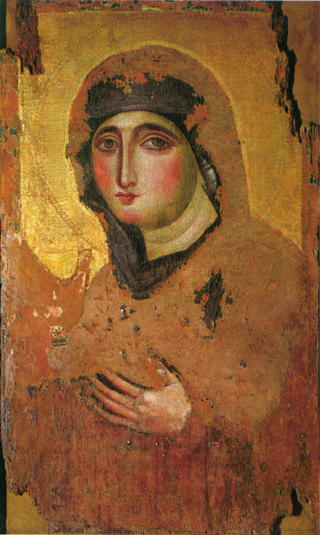
Mary was a first-century Jewish woman of Nazareth, the wife of Joseph and the mother of Jesus. She is a central figure of Christianity, venerated under various titles such as virgin or queen, many of them mentioned in the Litany of Loreto. The Eastern and Oriental Orthodox, Church of the East, Catholic, Anglican, and Lutheran churches believe that Mary, as mother of Jesus, is the Mother of God. Other Protestant views on Mary vary, with some holding her to have lesser status.

According to apocrypha, as well as Christian and Islamic tradition, Saint Anne was the mother of Mary, the wife of Joachim and the maternal grandmother of Jesus. Mary's mother is not named in the Bible's canonical gospels. In writing, Anne's name and that of her husband Joachim come only from New Testament apocrypha, of which the Gospel of James seems to be the earliest that mentions them. The mother of Mary is mentioned but not named in the Quran.

Christian art is sacred art which uses subjects, themes, and imagery from Christianity. Most Christian groups use or have used art to some extent, including early Christian art and architecture and Christian media.

Veneration, or veneration of saints, is the act of honoring a saint, a person who has been identified as having a high degree of sanctity or holiness. Angels are shown similar veneration in many religions. Veneration of saints is practiced, formally or informally, by adherents of some branches of all major religions, including Christianity, Judaism, Hinduism, Islam, Buddhism and Jainism.

The Assumption of Mary is one of the four Marian dogmas of the Catholic Church. Pope Pius XII defined it on 1 November 1950 in his apostolic constitution Munificentissimus Deus as follows:
We pronounce, declare, and define it to be a divinely revealed dogma: that the Immaculate Mother of God, the ever Virgin Mary, having completed the course of her earthly life, was assumed body and soul into heavenly glory.

The Dormition of the Mother of God is a Great Feast of the Eastern Orthodox, Oriental Orthodox, and Eastern Catholic Churches. It celebrates the "falling asleep" (death) of Mary the Theotokos, and her being taken up into heaven. It is celebrated on 15 August as the Feast of the Dormition of the Mother of God. The Armenian Apostolic Church celebrates the Dormition not on a fixed date, but on the Sunday nearest 15 August. In Western Churches the corresponding feast is known as the Assumption of Mary, with the exception of the Scottish Episcopal Church, which has traditionally celebrated the Falling Asleep of the Blessed Virgin Mary on 15 August.
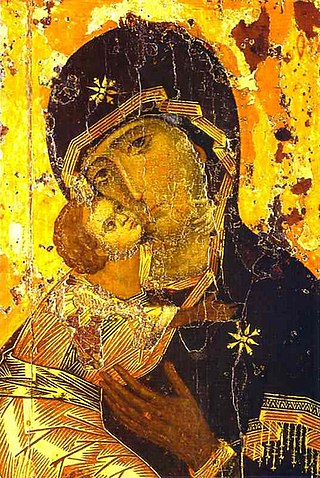
The perpetual virginity of Mary is a Christian doctrine that Mary, the mother of Jesus, was a virgin "before, during and after" the birth of Christ. In Western Christianity, the Catholic Church adheres to the doctrine, as do some Lutherans, Anglicans, Reformed, and other Protestants. The Oriental Orthodox Churches also adhere to this doctrine as part of their ongoing tradition, and Eastern Orthodox churches recognize Mary as Aeiparthenos, meaning "ever-virgin". It is one of the four Marian dogmas of the Catholic Church. Most modern nonconformist Protestants reject the doctrine.
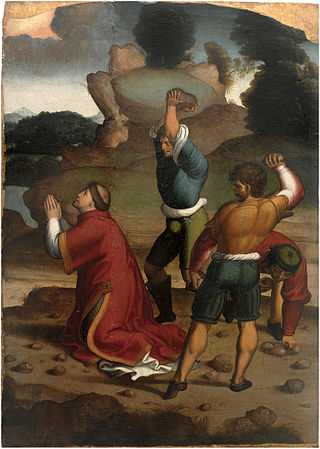
In Christianity, a martyr is a person who was or is killed for their testimony for Jesus or faith in Jesus. In years of the early church, stories depict this often occurring through death by sawing, stoning, crucifixion, burning at the stake, or other forms of torture and capital punishment. The word martyr comes from the Koine word μάρτυς, mártys, which means "witness" or "testimony".

Church of the Sepulchre of Saint Mary, also Tomb of the Virgin Mary or the Church of the Assumption, is a Christian church built around an ancient Jewish rock-cut tomb in the Kidron Valley – at the foot of Mount of Olives, in Jerusalem – believed by Eastern Christians to be the burial place of Mary, the mother of Jesus. The Status Quo, a 250-year old understanding between religious communities, applies to the site.
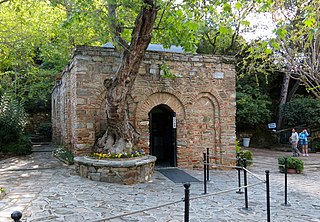
The House of the Virgin Mary is a Catholic shrine located on Mt. Koressos in the vicinity of Ephesus, 7 kilometres (4.3 mi) from Selçuk in Turkey.
The Antidicomarians or Antidicomarianites, also called Dimoerites, were a Christian sect active from the 3rd to the 5th century. Their name was invented by an opponent, Epiphanius of Salamis, who described them as heretical in his Panarion. The existence of the Antidicomarians as an organized sect may be doubted, as it is attested only in Epiphanius, but the doctrines he attributes to them were certainly matters of live debate in the late 4th century.

The concept of Seven Archangels is found in some works of early Jewish literature and in Christianity. In those texts, they are referenced as the angels who serve God directly.
Anglican Marian theology is the summation of the doctrines and beliefs of Anglicanism concerning Mary, mother of Jesus. As Anglicans believe that Jesus was both human and God the Son, the second Person of the Trinity, within the Anglican Communion and Continuing Anglican movement, Mary is accorded honour as the theotokos, a Koiné Greek term that means "God-bearer" or "one who gives birth to God".

Abbey of the Dormition is a Catholic abbey belonging to the Benedictine Order in Jerusalem, on Mount Zion, just outside the walls of the Old City near the Zion Gate. The Abbey is said to mark the spot where Mary, mother of Jesus, died.

Mariology is the theological study of Mary, the mother of Jesus. Mariology seeks to relate doctrine or dogma about Mary to other doctrines of the faith, such as those concerning Jesus and notions about redemption, intercession and grace. Christian Mariology aims to place the role of the historic Mary in the context of scripture, tradition and the teachings of the Church on Mary. In terms of social history, Mariology may be broadly defined as the study of devotion to and thinking about Mary throughout the history of Christianity.
Marian feast days in the liturgical year are celebrated in honour of the Blessed Virgin Mary. The number of Marian feasts celebrated, their names can vary among Christian denominations.
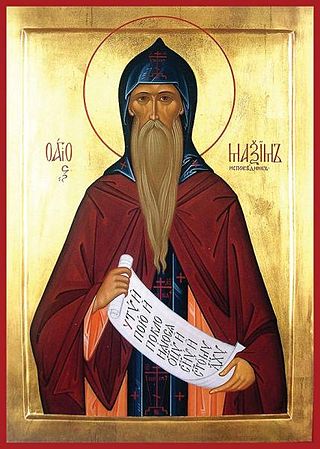
The Life of the Virgin is the earliest known biographical work on the Virgin Mary. Its only extant copy is in a Georgian translation attributed to the seventh-century saint, Maximus the Confessor, although the attribution remains less than certain.
The Euthymiac History is a Chalcedonian ecclesiastical history preserved today only in fragments quoted in other works. It is notable for containing the earliest reference to the doctrine of the Assumption of Mary.
The Theosophy of Tübingen is a manuscript of an epitome of the last four books of an earlier, lost Byzantine work of eleven books called simply Theosophy or On True Belief. The original work contained seven books on the right way to keep faith, and ended with four books of appendices containing the testimonials of pagans to the Christian faith. Its name derives from Tübingen, the city in Germany where the surviving manuscript is kept, at the University Library of Tübingen.
References
- ↑ "Stephen J. Shoemaker". Radcliffe Institute for Advanced Study at Harvard University. Retrieved 2023-05-27.
- ↑ "Stephen Shoemaker | Department of Religious Studies". religion.uoregon.edu. Retrieved 2023-05-27.